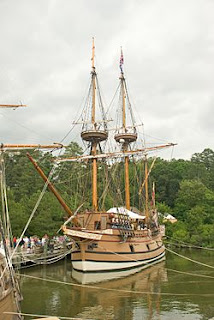Hampton Roads has many ties to the 17th and 18th century, arguably being the birth place of the United States. During the mid-twentieth century, Hampton Roads was in the grips of colonial revival. This is most evident today with the popularity of colonial-style buildings in the area that were built during the era, but can also be seen in the amount of colonial style furnishings that appear in local second-hand stores. In order to understand why Hampton Roads was so crazy over the style vs. french provincial, mediterranean, mid-century modern, or other styles of the period, we have to understand the importance of the 17th and 18th century to the area. Today begins a 4-part series on the colonial era and its effect on mid-century Hampton Roads, particularly the Peninsula. This series will include articles on Jamestown, Williamsburg, and Yorktown (each of which had at least one major celebration during the mid-century) and the Colonial Parkway, which connects them all.
We begin with Jamestown. As we learned in school, in 1607 the first permanent English settlement was founded in North America here at Jamestown. In 1957, Jamestown celebrated its 350th anniversary and Virginia celebrated the event with an 8-month-long "Jamestown Festival." During this time over a million visitors came to Jamestown, including then-Vice President Richard Nixon and Queen Elizabeth II.
Although the events surrounding the 1957 celebrations did not fully take into account the perspectives of the Native Americans and African Americans, they still made many lasting historical contributions to the local history and infrastructure. Organizers worked on a variety of projects including "microfilming colonial documents from England, publishing a series of thirty-two historical booklets about the colony written by prominent scholars, (and) excavating part of the town on Jamestown Island." The state also built the "Jamestown Festival Park," now known as the Jamestown Settlement, a living-history museum that included recreations of the three ships that brought the colonists to the island, James Fort, and a Native American village. This park created a "detailed presentation of the past, demonstrating everyday aspects of colonial life such as what people ate, how they dressed, the types of homes they lived in, and crops they grew."
The facilities were recently updated for the 400th anniversary in 2007. The Jamestown Settlement and Historic Jamestowne Island National Park are both open to the public and show that the efforts put into the parks in the mid-century were not in vain. By building upon what was created in the 1950s, both museums now better reflect the views of all of Jamestown's residents and help visitors to understand what life was like in the 17th century.
Sources:
www.wikipedia.com
www.encyclopediavirginia.org


